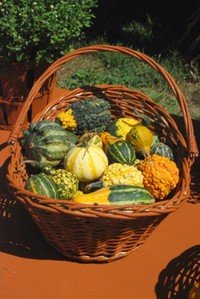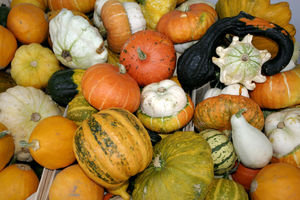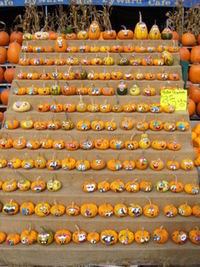





There are many stories through out the harvest season about giant pumpkins, giant watermelons, and even giant squash. It's the little ones that oftentimes win over the children. Depending on whom you ask, a miniature pumpkin may be classified as a squash, gourd, or pumpkin.
(Editor's Note: This article was originally published on November 20, 2008. Your comments are welcome, but please be aware that authors of previously published articles may not be able to promptly respond to new questions or comments.)
Miniature pumpkins are easy and fun to grow. They are perfect for smaller children to help with as they are easily managed. These little beauties are small enough--even at their fully grown size--for little hands to pick and carry. Miniature pumpkins may not qualify for any giant pumpkin competitions but they are definitely a must have for fall holiday decorating. They make beautiful centerpieces when placed in baskets with other fall harvest vegetables as well as having many other uses.
Growing miniature pumpkins; such as 'Jack Be Little' or 'Wee-B-Little', takes up far less space than the larger pumpkins. Another miniature variety that works great for decorating is the 'Baby Boo' pumpkin--it is actually white in color when ripe. You can grow pumpkins on a scaled down basis in containers. Miniature pumpkins can also be planted along fence lines, trellises, arbors, balconies or railings.
Growing Instructions
Pumpkins intended for Halloween should be planted in May in the northern states, and anytime from June to early July for the southern states with longer growing seasons. Allow ninety to one hundred days for the pumpkins to reach maturity. It is important to note if they are planted too early they may rot before Halloween. Pumpkins need to be watered well and watered often. The soil should be kept between damp and moist, however not saturated all of the time. Remember to allow enough time before dark for the leaves to dry in order to prevent fungus from growing. It is also important to fertilize the soil early in the growing season. Mulching well around the plants will retain moisture and keep the weeding that has to be done to a minimum.
Threats to the Patch
There are many animal and insect pests that will enjoy the fruits of labor put into a pumpkin patch if the appropriate pesticide or repellent is not used. It is important to spray or dust early before any sign of infestation is seen. The most likely insect assailants on the pumpkin patch are squash bugs, squash vine borers, as well as cucumber beetles. Aside from insects there are other threats to the pumpkin patch. There are many pepper or garlic sprays that can be used in order to keep rabbits, chipmunks, woodchucks, squirrels and deer at bay. For more advice on which insecticides or animal deterrents to use in your area, check with your local nursery or agricultural center. The most common disease problem for pumpkins is powdery mildew. To treat, apply fungicides at the first signs of problems, or avoid problems by applying a fungicide before mildew appears. 
Harvesting the Bounty
Harvesting miniature pumpkins is quite simple once they are ripe. Remember that the stem is important to many decorating designs so use a sharp knife or a pair of scissors. Take care and supervise small children when they are helping in the harvesting process. Miniature pumpkins are firm and fully orange when ripe unless they are 'Baby Boo' pumpkins, which are white when ripe.
Reaping the Benefits
There are many uses for the 'Jack Be Little' pumpkins as well as other mini varieties. The most common use is Halloween and Thanksgiving decorations. When arranged in a basket they make a beautiful centerpiece straight out of the garden. If the desire is to be more unique or fancy, the pumpkins can be painted to go with any particular party or holiday theme.  They can also be carved into mini jack-o'-lanterns for a Halloween party.
They can also be carved into mini jack-o'-lanterns for a Halloween party.
Miniature pumpkins are edible; there are many recipes available for pumpkins purees, soups and pies. Another use for the miniature pumpkins is to use them as a serving dish for individual serving sizes at dinner parties. The food in them can be either hot or cold. Simply cut the tops off the pumpkins and scoop the insides out. You can put stuffing or a casserole in the pumpkins and bake it right in the pumpkin shell. You can pour your favorite soup into a warmed up shell to help keep it warm. The shells work great for desserts as well, ice creams, puddings, and purées. They are guaranteed to be a topic of conversation. Your guests will be talking about your party well after the event has ended.
So when you are planning your next gourmet garden, consider throwing out a few miniature pumpkin seeds. Then you can enjoy the benefits of this tiny beauty throughout the holiday season.
Happy Gardening
To find recipes for pumpkin dishes and deserts http://www.allrecipes.com/
All photos are courtesy of Wikipedia.org
Copyright © www.100flowers.win Botanic Garden All Rights Reserved